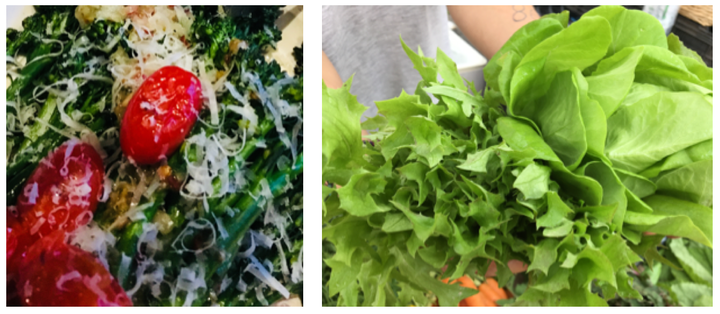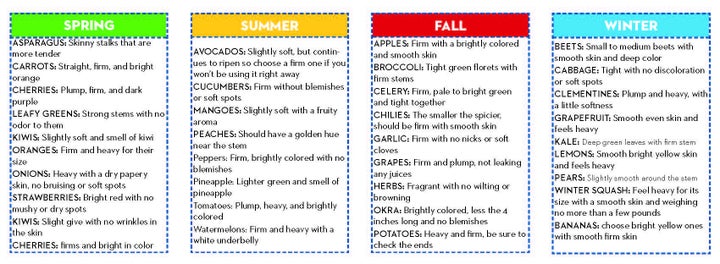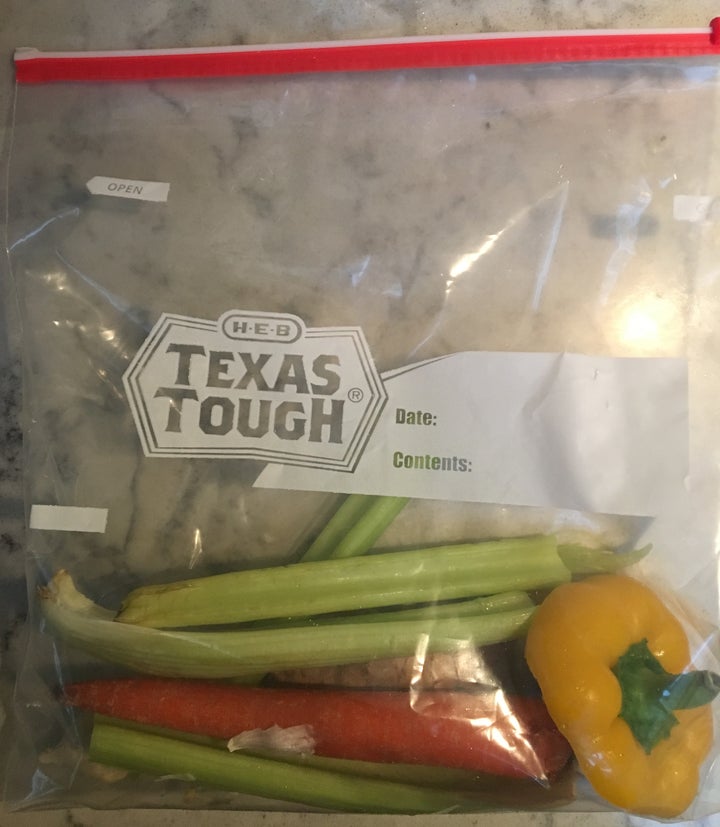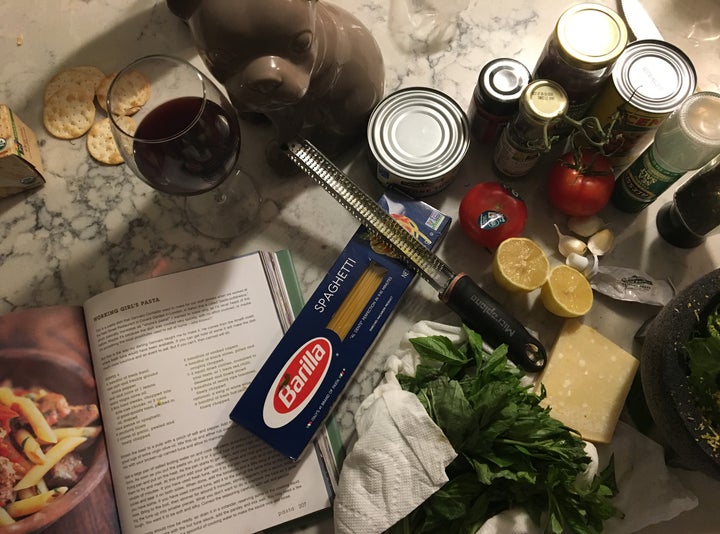Every January, millions of Americans resolve to ring in the New Year with healthier, more active lifestyles. But turning those good intentions into healthy habits can be difficult, especially without a dedicated support system. Eating habits begin at home and are ingrained at an early age, which makes it all the more important to have friends and family share in the quest for the best possible way to live. With a focus on food as fuel and the table as the gathering place to bring family together, cooking and eating healthy meals with the ones we love becomes part of our vocabulary, it becomes ritual.
Common Threads is kicking off 2018 by celebrating its third annual Cooking for Life Month to call attention to the importance of equipping our country’s children and their families with nutrition knowledge and practical cooking skills. Teaching children and families to eat home-cooked meals allows for healthier choices, setting the table for an improved relationship with food.
We rallied several talented, passionate foodie experts to create 10 simple tips to help families get Cooking for Life in 2018:
1. Make Fruits & Veggies Fun!
The USDA’s MyPlate and the Common Threads Chef’s Plate both recommend that half of a nutritious diet be made up of fruits and vegetables, or 5-8 servings every day. Fruits and vegetables are a great way to manage blood sugar (bok choy); suppress coughs (summer squash); improve immunity (arugula); and prevent inflammation and cognitive decline (snow peas). I love to challenge myself by focusing on the more nutrient-packed veggies and working to perfect a couple different preparations of them for my family. Remember: paint your plate with color, the brighter the better, the more color, the more nutrients!

Rapini (left), broccoli’s nutrient-packed cousin, is available year-round, and is high in both vitamin B (a great migraine reducer) and cancer-fighting omega-3 fatty acids. Green leaf lettuce (right) helps to improve mood and vision.
A survey by Impulse Research revealed that 66% of Americans found grocery shopping to be more time-consuming than any other household task, and a major reason for not cooking more at home. But that time perusing the aisles can be an opportunity for family time.
“Take your kids shopping with you,” said Douglas Lammie, an RDN and the Health Education Coordinator at UIC’s Chicago Partnership for Health Promotion. “Studies show kids are more likely to eat the food when they pick it out.”
Make a bingo board of fruits and veggies and cross one off each time someone tries a new one! Or bring your kids with you to the store and assign them a color of new food to try.
“Use your kids’ competitive spirit to your advantage and tell them to see who can eat the most colors during mealtime,” said Frances Largeman-Roth, registered dietitian nutritionist (RDN), nutrition expert and New York Times best-selling author. “Kids eat with their eyes just like we do.”
2. Shop In-Season
Shopping with the growing seasons can help you bring the tastiest healthy ingredients into your home for the most affordable prices. In-season fruits and veggies, picked when they are the ripest and freshest, taste delicious and retain the essential nutrients we need for long-lasting health benefits.
Shopping for in-season produce can also be very easy: when farmers grow and sell more of these items, you will see more products on the shelves, which translates to more affordable prices for shoppers.

Common Threads’ seasonal produce guide helps families determine which fresh fruits and vegetables will be most affordable throughout the year.
To get you ready for tomato season, Chef Dena Marino, Co-owner and Executive Chef of MC Kitchen, says, “Pick your tomatoes based on smell, try to buy on-the-vine, which are typically fresher. Yellow tomatoes are okay—just stay away from tomatoes with a funky smell. Tomatoes kept in the refrigerator become mealy and unappetizing—make some counter space for those babies!”
3. Make S.M.A.R.T. Changes
“Changing eating habits is hard, and doing too many at once is even harder,” said Lammie. “Make Small, Measureable, Attainable and Realistic Goals over a period of Time.”
Not only will it be harder to eat healthier if you try to overhaul your diet all at once, but your family will certainly take notice when all their favorite foods or snack items are suddenly missing from the fridge and pantry. For example, Lammie suggested switching from whole milk to skim milk as one simple choice that can save thousands of calories over time. Also, replacing mayonnaise with avocados will give you a creamy, healthier salad dressing. Avocados add a creamy texture to green smoothies; we are obsessed with an avocado, spinach, mango, pineapple and coconut water combo in our house. Avocados are also a terrific substitute for heavy whipping cream if you have a craving for chocolate mousse.
For my family, I try to cut up veggies on the weekend and place them into easy-to-spy containers in the fridge, which makes the healthy choice easier when we’re craving something crunchy. Homemade pesto (arugula is the favorite lately), nut blends, trail-mix and air-popped popcorn jazzed up with lemon and parmesan are delicious healthy snack replacements. You can also try substituting soda or fruit juices (often loaded with added sugars and containing little real juice) with more natural juices or flavored waters.
4. Don’t Give Up Your Favorite Food!
Try as we might to eat healthy, there always seems to be that one guilty pleasure food we can’t stop craving. Rather than feeling like we have to eliminate family favorites from the dinner rotation, we can instead make simple tweaks to add more nutrition to those tasty treats.
For instance, Tamron Hall is not one to deny herself her favorite foods. Having a career that puts her in the limelight, she practices moderation to help her maintain a healthy lifestyle. When she tried eliminating sugar from her diet, she was disappointed that it didn’t work out for her. Instead, she now focuses on portion control, and enjoys a healthy, fat-free, yogurt smoothie for her daily breakfast.
“Homemade is pretty much always healthier than going out to eat, so if there’s something your family really loves, try making it at home,” Largeman-Roth said.
Controlling the ingredients used will make it easier to enjoy nutritious dinners that your family will still love. For instance, try using a whole wheat pizza crust, cutting back slightly on the amount of cheese, or replacing high-fat meat toppings with healthier fresh veggies such as spinach, onions, peppers and fresh tomatoes.

Common Threads’ online resource Common Bytes has a library of more than 100 nutritious recipes, including these for whole wheat pizza dough and a healthy tomato sauce.
5. Pile on Layers of Flavor
“Think outside the box and lean on menus of your favorite restaurants for unique flavor combos,” said Todd Erickson, Executive Chef of GLAM Vegan Miami, Society Ft. Myers and Huahua’s Taqueria South Beach in Miami. “A diverse array of ingredients like raisins, cumin, cinnamon, almonds, tomatoes, and carrots brings an unforgettable punch to Taco Tuesdays!”
If your dish is still missing that extra kick, try adding salt and acid – the duct tape and WD40 of cooking. Seasoning each component of the dish separately will ensure that every bite is bursting with a different kind of flavor.
“It may be surprising, but many chefs agree that salt alone can spruce up a dish,” Erickson said. “Sometimes all it takes is a dash of salt and a squeeze of lemon.”
Even a plain salad can be livened up by replacing lettuce with roughly chopped herbs like dill, cilantro, and basil.
6. Batch Cook on the Weekend
Things move so quickly during the week that it can be daunting to try to carve out time each night to make dinner as well as lunches for the next day. Batch cooking is a great way to build up a reserve of healthy meals that the family can enjoy throughout the week. It’s as simple as setting aside a couple hours on Saturday or Sunday morning to fill the fridge with homemade “convenience foods” like roasted chicken that can be cut up and incorporated into dishes throughout the week.
Gail Simmons, of Food & Wine and Top Chef, recommends keeping a freezer bag for all your vegetable and herb scraps like peppers, zucchini, squash, mushroom stems, carrot peels, fresh herb stems, leftover garlic, ginger, celery ends and onions, and filling it over several weeks. That bag of bits will not only cut down on waste in your kitchen but eventually can be thrown in a pot to boil as the base for a delicious veggie or chicken stock.

Wash and cut veggies so they’re ready to be cooked (or snacked on)—then when it’s time to eat, you’re halfway to a meal! This is a great way to involve the kids when they may have more free time on the weekend.
7. Pick Your Emergency Meals
Even the best laid plans are hard to keep up with week in and week out. That’s why it’s useful to have a short list of three or four tried and true go-to, healthy meals that are easy to make and will please your family. Just make sure that the ingredients you need are on every grocery shopping list.
For our family, this usually means a simple Caesar salad and pasta with a turkey and veggie ragù. I love to make pasta sauces and taco fillings and freeze them. That way, when life gets busy, there is always a nutritious choice that is in line with my family’s health goals. I always stock my cupboard and fridge with boiled eggs, nut spreads, fresh fruit, oatmeal, Greek yogurt, whole grain cereal and trail mix for making healthy breakfasts and on-the-go snacks.

Pasta with a simple salad is a go-to in our household.
“Don’t forget about the versatility of eggs,” says Timon Balloo, Executive Chef at Miami’s SUGARCANE Raw Grill Bar. “Eggs are a cheap source of protein that can contribute flavor and substance to a variety of meals, not just breakfast. Check out these ideas for breaking the breakfast barrier.
8. Safety First!
Without a doubt, the most essential kitchen tool that everyone needs is a good chef’s knife. It doesn’t need to be too fancy or expensive. Keep it sharp by using a steel sharpener, or you can have it sharpened at any cooking supply store. James Beard Award winning chef, restauranteur and TV host Michelle Bernstein recommends hitting Ace Hardware Stores, many of which offer free sharpening while you shop. Keeping your knife sharp not only makes it easier to use but also makes it safer to use.
“This may seem like a contradiction, but dull knives will often resist your natural chopping and slicing motions, which can lead to dangerous slippage that could potentially catch some skin,” explains Chef Richard Ingraham, personal chef for Cleveland Cavaliers star Dwyane Wade.

Chef Richard Ingraham takes a break for sharing his best kitchen safety tips to cook for the winning family of Common Threads’ 2017 Cooking for Life social media giveaway. Photo: @chefrli
Don’t run the knife through the dishwasher, and make sure to keep your knife separate from other dishes in the sink. This will protect you from the misfortune of grabbing a (now perfectly sharpened) knife hidden beneath other dirty dishes. Try to keep your knife in a place where it won’t get banged up. And the most important tip of all, as Richard explains, “If a knife should fall, let it drop. Do not try to catch it. As the old saying wisely warns, ‘A falling knife has no handle.’” For some more quick tips and demos on knife skills, check out Common Threads’ video tutorial:
9. Make Healthy Cooking a Family Affair!
Cooking, like art or music, enhances childhood development and stimulates the brain. Kids use math and reading skills to follow a recipe and measure out ingredients, practice attentiveness by concentrating on the task at hand and express creativity by experimenting with new ingredients and techniques. Research by the National Center on Addiction and Substance Abuse at Columbia University has shown that kids who frequently eat with their families were twice as likely to report better grades, and JAMA Pediatrics research showed that they are less likely to succumb to substance abuse, become depressed or consider suicide. Plus, kids love to eat what they have cooked.
“We ate dinner together almost every night until I left for college,” said Melissa Joulwan, author of the Well Fed cookbook series, who still reminisces about pretending to host a TV show in her home kitchen while cooking scrambled eggs. “It gave us an opportunity to really talk about what was happening in our lives - the good and the bad - I think it’s really challenging for families to carve out that time together, but I also think it’s really important, at least once a week, to sit down together, have some real talk and eat delicious food together.”
Think about planting a small family garden together or use containers to grow fresh herbs and veggies.
“I enjoyed and appreciated growing food,” said Chef Govind Armstrong, who now has three restaurants in southern California. “Knowing where it came from taught me how to genuinely appreciate food early on.”
Years later, Govind still has his garden, and he is now creating the same tradition with his four-year-old daughter, who has her own special stool in the kitchen where she can cook by her dad’s side. Each day, they head out to their garden together, watering and tending to the plants and veggies.
“I see the excitement in her eyes and hear discovery in her voice every day. Tomatoes, herbs and cucumbers are her favorites.”
If you need inspiration, the Common Threads Cooking for Life Handbook has eight full weeks of nutritious, budget-friendly meals like Sweet Potato Black Bean Empanadas, Mediterranean Roasted Eggplant and Garbanzo Red Pepper Salad that will spice up the weekly menu and introduce the kids to new ingredients. Common Threads’ online resource, Common Bytes, hosts a growing library of more than 100 healthy recipes. Ask friends and relatives to share recipes as well.
“My son was a very picky eater until recently,” said Chef Dena Marino. “I’ve learned to involve him in the planning, preparation and cooking. Spending that time together as a family has allowed us to get past any aversions that he may have had towards different foods. And it makes me smile.”
10. Cook Your Way Around the World
This fun challenge will get the whole family involved in learning about different cultures and types of cuisine. We know it works because Common Threads students across the country do this together each week—and you can too. Let each family member pick a different country and see which exotic new dish becomes a family favorite. Introducing ourselves to food from other parts of the world allows us to understand and appreciate other cultures.
Learning and adopting new culinary traditions allows us to broaden our horizons and acquire the knowledge and skills we need to form healthy eating habits.
“I make time for cooking at home every single day with and for my family,” said Chef Michelle Bernstein. “It’s not easy, but when you make a list of the most important things in your life and your family is on the top of that list, you make exceptions and time for the important things. Wholesome food is that for me.”
This year, experience the joy of sharing new foods and making memories in the kitchen while getting your family Cooking for Life!
